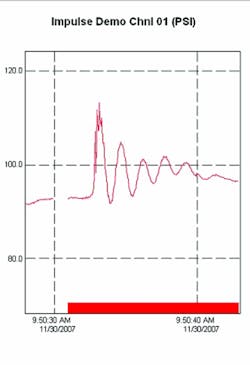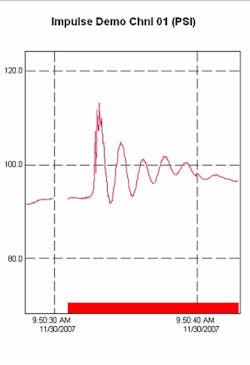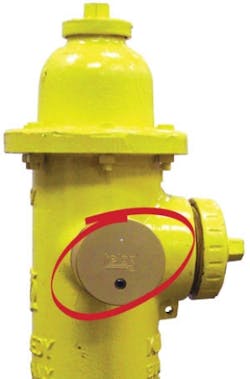Impulse Detection Leads to Mitigation of Pressure Events
By Barry Ceci
Water hammer events can result in service issues for utilities, as the sudden increase in pressure can contribute to pipe fatigue, eventually causing pipe failure.
Negative pressure events (transients) can have significant impact on water quality as well: The low pressure created inside the pipe can pull stagnant water into the pipe through leakage points, cross-connections and faulty seals or joints. When this stagnant water enters the pipe, it can bring waterborne disease molecules and harmful biologics into the main. This can contaminate a municipal water supply with non-potable water.
Finding the sources of these events and understanding their severity can allow water utilities to mitigate potentially hazardous situations. Knowing the source can help municipalities guard against costly, often destructive water main breaks.
Locating the Source
Pumps that turn on and off and valves opening and closing too rapidly are usually the source of transient events, often produced by large industrial customers.
Generally, water distribution managers know what could be causing pressure events. The challenge comes in gathering the data they need to determine exactly where and when these events take place, so they can recommend an action plan for changes in these areas.
The solution to acquiring this data is simpler than many utilities realize. Hydrant pressure recorders and line pressure recorders monitor water pressure throughout the distribution system, capturing the waveform of water hammer and negative pressure events. Pressure recorders developed by Telog Instruments, for example, can store up to 450 events of variable duration that may occur over many months of on-site monitoring.
The recorders can be placed upstream or downstream of the predicted problem site, collecting data during transient events at rates up to 20 measurements a second. Field personnel can then transfer the data using a portable PC or a dedicated transfer unit, and download the data to the utility's information management system.
The resulting comparisons of trend and impulse data provide graphical illustrations of the impulse event, with the accompanying numerical data that documents the pressure change in PSI and the duration of the event. This data provides proof of the event and its impact on the system components through which it passed. It can also be used to calibrate a distribution system model to help predict the impact of future events.
Impulse Recording
To illustrate this process, we begin with a recorder configured for trend recording and impulse detection with the following parameters:
- Sample Rate: 50 milliseconds (ms)
- Trend Recording Interval: 5 minutes
- Pressure Change threshold: 5 PSI
- Pressure Change within: 10 seconds (Scan Window)
- Store pre-impulse data for: 15 seconds
- Store post-impulse data for: 20 seconds
Based on these settings, the recorder will sample the pressure 20 times per second and compute the difference between the maximum and minimum values within a 10-second rolling Scan Window.
If the difference is greater than the Pressure Change threshold, the recorder immediately triggers an impulse condition. As determined by the pre-impulse data setting, the recorder stores 50 ms data for the 15 seconds prior to the impulse detection, as well as for the current sample.
The recorder will continue to store 50 ms samples as long as the difference within the Scan Window is greater than the Pressure Change threshold. Once the difference drops below the Pressure Change threshold, the impulse event will be considered over and the recorder will continue to store data at the 50 ms Sample Rate for 20 seconds, as determined by the setting in the post-impulse data window.
If the recorder detects another impulse at any time, the device goes back into impulse mode and repeats the process.
When the data is downloaded into the accompanying information management software–in this case, Telogers for Windows–users can view impulse data along with the trend data. For durations in which impulse data was detected, the software displays the impulse data on the chart in a different color. Since the impulses are asynchronous, the software will not connect the points between the trend and impulse data transition on the chart.
The software also displays an extra bar at the bottom of the chart to indicate an impulse event. In the tabular data, the impulse data is displayed under the average column, and the rows that contain the impulse data are highlighted to distinguish them from the trend data.
Modeling
Some water distribution modeling companies have developed software that may allow water utilities to predict water transient events. These packages work with standard analysis software like Telogers Enterprise to simulate transient phenomena and predict the impact of events with a wide range of causes.
Pressure recorders developed by Telog Instruments can store up to 450 events of variable duration that may occur over many months of on-site monitoring.
The critical element to modeling of this kind is calibration of the model, to be sure that the model reflects the likelihood of actual events. Data recorded by Telog's impulse detection devices can be instrumental in calibrating the modeling program, improving the utility's ability to forecast water hammer and negative pressure events, and plan practical solutions that may prevent these phenomena from damaging the water distribution system.
Using real data collected during pressure events, utilities can verify the events' source and make the case for mitigation of their impact on system components. With this empirical data, users also can predict the impact of future events, calibrating a model to reduce or eliminate the impact of such events before they happen.
About the Author:Barry Ceci is the founder, president and CEO of Telog Instruments, a remote data acquisition provider to the water distribution and wastewater management industry.
More WaterWorld Current Issue Articles
More WaterWorld Archives Issue Articles


